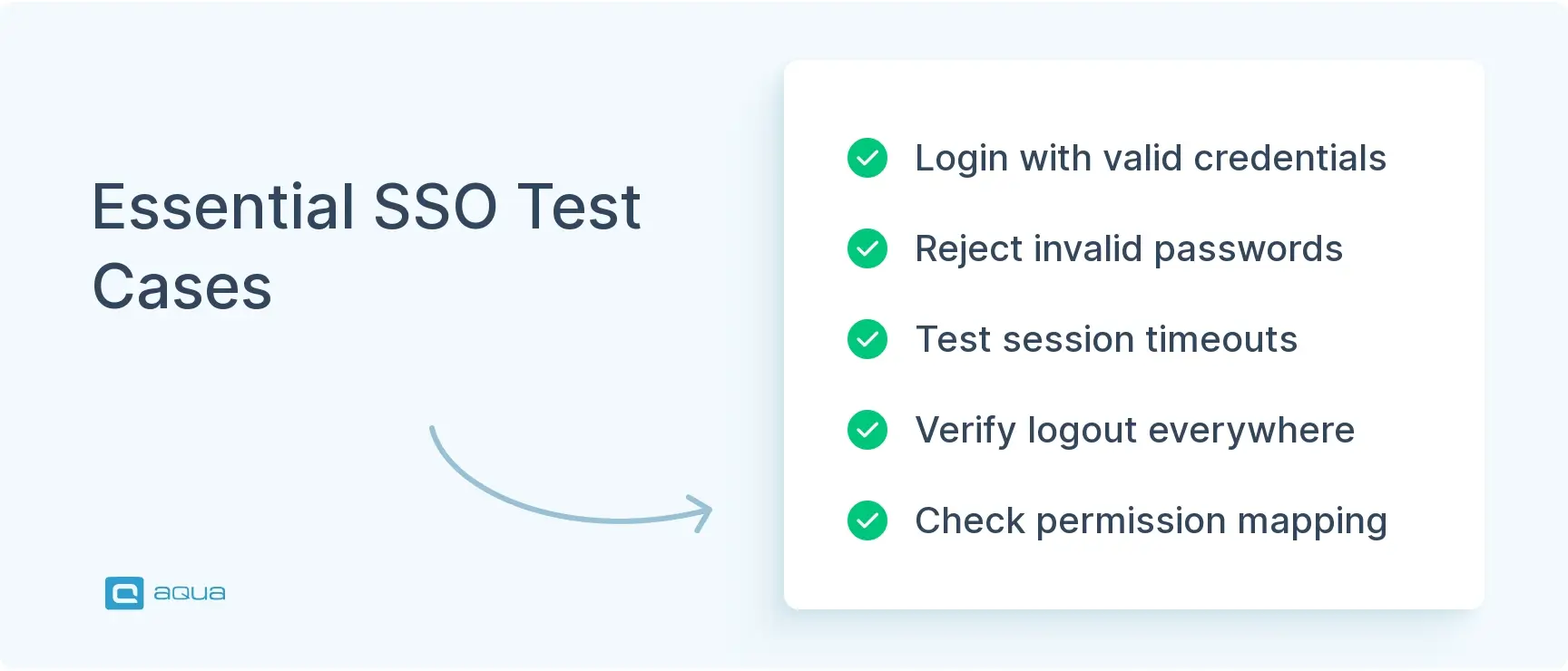Key Takeaways
- SSO testing verifies authentication workflows across multiple applications, focusing on failure points like miscommunicated user identities, asynchronous session expirations, broken permission mapping, and incomplete logout processes.
- The most common SSO failures occur during handoffs between systems when the identity provider and applications fail to properly exchange tokens or assertions.
- Comprehensive SSO testing must cover functionality, security, performance under load, cross-platform compatibility, and error handling scenarios.
- Essential test cases should include authentication basics, session management, permission verification, and edge cases like network interruptions and certificate expirations.
- Tools like Selenium, Fiddler, SAML-tracer, and JMeter help automate and debug SSO testing across browsers, protocols, and load scenarios.
When SSO fails, your entire organization grinds to a halt as users can’t access critical applications. Discover how to properly test your authentication system before it becomes a ticket nightmare 👇
What is SSO Testing?
SSO testing is the process of verifying that your Single Sign-On solution works correctly across all integrated applications. You also have to achieve it while maintaining proper security protocols. Unlike testing a standard login form, SSO testing examines the entire authentication workflow across multiple systems. Remember testing a basic login page? Enter username, enter password, click submit, verify you’re logged in. SSO testing throws that simplicity out the window. With SSO, you’re not just testing one login. You’re testing whether a user can log into the identity provider, get redirected back to the application they wanted, and actually have access to what they need. Then you test whether they can hop to a second application without logging in again. And a third. And whether their session stays active across all of them.
Think about how Google’s authentication works – sign in once, and you’ve got access to Gmail, YouTube, Google Drive, and other Google services without additional logins. SSO testing ensures this handoff between applications happens correctly every time.
Here’s what breaks most often:
- Login works, but apps don’t recognise the user: – The identity provider says “yes, this person is valid”, but the target application doesn’t get the message properly.
- Sessions expire at different times: – User logs into App A fine, but when they try App B an hour later, they’re mysteriously logged out.
- Permissions don’t transfer correctly: – User has admin rights in the identity provider, but shows up as a regular user in connected applications.
- Logout doesn’t work everywhere: – User logs out of one app but remains logged into others, creating security problems. Most SSO failures happen in the handoff between systems. Your identity provider and your applications need to speak the same language using tokens or assertions. When that communication breaks down, users get stuck in authentication loops or can’t access anything at all.
Each of these steps presents potential failure points that your testing needs to cover – from network issues to configuration problems to compatibility challenges.
Benefits and Importance of SSO Testing
SSO failures can shut down your entire organisation’s productivity. When authentication breaks, users can’t access email, CRM, project tools, or anything else they need to work. Here’s what proper SSO testing prevents:
- Flood of support tickets – Users can’t access email, CRM, or project tools and blame IT instead of working
- Security vulnerabilities – Authentication bugs become entry points for attackers to access multiple systems
- Integration failures – Your identity provider and applications stop talking to each other after updates
- Cross-browser problems – SSO works in Chrome but fails in Safari, leaving some users stranded
- Session timing issues – Users get randomly logged out or stay logged in when they shouldn’t
- Permission mapping errors – Admins lose access rights or regular users gain admin privileges
- Performance bottlenecks – Login process takes forever during peak usage times
How to Test SSO Systems
SSO testing isn’t like testing a regular login form. You’re dealing with multiple systems that need to work together, and there are more ways for things to go wrong.
Test Basic Functionality First
Before you dive into edge cases, make sure the basic flow actually works. Log in with a valid user account and see if you can access the applications they’re supposed to reach. Try jumping between different apps without logging in again. Test the logout process by signing out and making sure it actually kicks you out of everything.
The most common failure here is partial access – login works, but the user can only reach some of their applications. Key things to verify:
- Login with valid credentials reaches all authorised applications
- Session timeouts work as configured
- Logout terminates access across all connected systems
- Password reset doesn’t break the SSO connection
Security Testing
SSO creates new attack vectors that don’t exist with individual logins. Try logging in with wrong passwords to make sure the system rejects them properly. Check that someone can’t manipulate the authentication tokens to gain unauthorized access.
Pay attention to session management. Users shouldn’t stay logged in forever, but they also shouldn’t get randomly kicked out while they’re working. Test what happens when someone tries to access an app after their session has expired.
The redirect process is another security risk. Make sure attackers can’t hijack the authentication flow to send users to malicious sites instead of legitimate applications.
Performance Under Load
Authentication bottlenecks affect everyone trying to work. Test login times during normal usage and see what happens when lots of people try to authenticate at once. Monday mornings and right after lunch are typical high-traffic times.
If your main authentication server goes down, does the backup actually work? Test your failover process before you need it in production.
Cross-Platform Compatibility
Your users aren’t all using the same browser on the same device. Test SSO in Chrome, Firefox, Safari, and Edge. Try it on phones and tablets. Check that it works with different versions of your connected applications.
Mobile apps often implement SSO differently than web applications, so test those separately. Some users might be on older versions of applications that handle authentication tokens differently.
Common compatibility issues:
- Different browsers handle redirects differently
- Mobile apps vs web applications use different SSO implementations
- Older application versions may have token handling bugs
Error Handling
Good error handling prevents support tickets and helps you debug problems. When someone enters the wrong password, they should get a clear message about what went wrong. When your identity provider is down, users should know it’s a system issue, not something they did.
Test what happens when the authentication process gets interrupted: network hiccups, browser crashes, or users closing tabs mid-login. The system should handle these gracefully instead of leaving users in a broken state.
The bottom line: SSO creates a single point of failure for your entire application ecosystem. When it breaks, everything breaks. That’s why testing it properly isn’t optional.
Speaking of the importance of thorough SSO testing, managing your test cases effectively is crucial for maintaining security and user experience. Using a dedicated test management system like aqua cloud can transform how you approach SSO testing across all those critical protocols and test cases we’ve discussed. With aqua, you can create comprehensive test cases for your authentication workflows using AI-powered generation, saving significant time while ensuring all security edge cases are covered. The platform allows you to centralise both manual and automated SSO tests in one place, making it easier to track test coverage across different applications and authentication scenarios. What’s particularly valuable for SSO testing is aqua’s nested test case capability, which lets you reuse common authentication steps across multiple test scenarios; update a core login flow once, and it automatically updates everywhere it’s used. Integrations like Jira, Confluence, Azure DevOps will supercharge your test management efforts, while security compliance with protocols like ISO 9001, FDA 21, and many more ensure your testing efforts stay secure.
Achieve 100% test coverage of your SSO workflows while cutting test case creation time by 97%
How to Test SSO Login
The SSO login process has more moving parts than a regular authentication system. Instead of just checking username and password, you’re testing a conversation between multiple systems that can break at several points.
SSO is primarily designed for human users. It helps people log in once and get access to many systems without typing passwords repeatedly. Non-human accounts (like service accounts, scripts, or integrations) usually don’t use SSO. As a best practice, I don't use it for any non-human accounts. Instead, they should use API keys, certificates, tokens, or secrets managed through a secrets manager or AWS IAM identity platform.
Test the Initial Login
Start with the most basic question: can users actually log in? Try accessing a protected application and watch what happens. The system should redirect you to your identity provider, let you enter credentials, then send you back to the application you wanted.
This is where most SSO implementations break. Users enter valid credentials but get error messages, infinite redirect loops, or land on the wrong page. Test with different user types – regular employees, admins, contractors, or anyone else with different permission levels.
Pay attention to timing. If the login process takes more than a few seconds, users will think something’s broken and try clicking buttons multiple times, which can cause more problems.
Check Session Management After Login
Once users are logged in, the real SSO magic should happen. They should be able to jump between applications without logging in again. Test this by opening multiple applications in different browser tabs and making sure you don’t see login screens.
Session problems usually show up here:
- User logs into App A but still gets a login screen for App B
- Sessions expire at different times across applications
- Users get logged out randomly while they’re working
Test what happens when users leave applications idle for different amounts of time. Your session timeout settings should work consistently across all connected systems.
Verify Logout Works Everywhere
Single logout is often the trickiest part of SSO to get right. When users log out of one application, they should be logged out of everything. Test this by logging into multiple applications, then logging out of one and checking whether you can still access the others.
The most common logout problem is partial logout – users log out of one app but remain logged into others. This creates security risks because users think they’ve logged out when they haven’t.
Also, test what happens when users close browser tabs instead of properly logging out. The system should handle this gracefully and not leave sessions hanging around indefinitely.
Testing Your SSO Implementation
Every SSO setup is different, and the specific technology you’re using affects what can go wrong. Your testing approach needs to match your implementation.
Test the Protocol You’re Using
Most SSO systems use either SAML or OAuth/OpenID Connect. Each has its own failure modes that you need to test specifically.
If you’re using SAML, the most common problems are signature validation failures and timestamp issues. Users get cryptic error messages when the identity provider and service provider have different system clocks, or when security certificates aren’t configured properly.
With OAuth and OpenID Connect, token handling is usually where things break. Test what happens when tokens expire, get corrupted, or when the authorisation server is temporarily unavailable. Make sure refresh tokens actually work when access tokens expire.
Test All Your Application Integrations
Make a list of every application that connects to your SSO system and test each one individually. Don’t assume that if SSO works with one application, it works with all of them. Different applications implement SSO differently, and each integration can have unique problems.
Pay special attention to:
- Legacy applications that might have outdated SSO implementations
- Third-party applications that you don’t control
- Mobile apps that handle authentication differently from web apps
- API integrations that use tokens for authentication
Test Federation if You Have It
Federation is when your SSO system trusts another organisation’s identity provider to authenticate users. For example, your contractors log in using their own company’s credentials, but your system accepts that authentication and gives them access to your applications. If your SSO system connects to external identity providers like this, test those connections separately. Federation adds another layer of complexity where things can break. The most common federation problems are attribute mapping issues. User information doesn’t transfer correctly between identity providers, so users end up with wrong permissions or missing profile data.
Essential SSO Test Cases
Here are the specific scenarios you should test for any SSO implementation. Focus on the ones that match your environment and user patterns.
Authentication Basics
Start with the fundamental login scenarios:
- Valid credentials get users logged in successfully
- Invalid passwords are rejected with clear error messages
- Locked accounts can’t log in but get helpful error messages
- Password reset works without breaking SSO functionality
- Multi-factor authentication prompts appear when required
Session Handling
Test how your system manages user sessions:
- Sessions expire after the configured timeout
- Users can’t reuse session tokens after logging out
- Multiple simultaneous logins work properly (or are blocked if that’s your policy)
- Administrators can terminate user sessions when needed
Permission and Role Testing
Verify that access controls work properly:
- Users only see applications and data they’re authorised for
- Permission changes take effect quickly
- Temporary access grants expire when they should
- Role changes don’t leave users with incorrect permissions
Edge Cases and Error Conditions
Test the scenarios that break most SSO implementations:
- Network interruptions during login don’t leave users stuck
- The browser back button doesn’t break the authentication flow
- Identity provider downtime is handled gracefully
- Certificate expiration warnings appear before certificates actually expire
- Brute force login attempts trigger account lockouts
Testing SSO properly takes more time than testing regular authentication, but the effort pays off when users can actually access their applications reliably. Start with the basic login flow, then work your way through session management, permissions, and edge cases. The key is being systematic – SSO has too many moving parts to test randomly and hope you catch everything.

Best tools for SSO testing
Manual SSO testing gets old fast when you’re dealing with multiple applications, different browsers, and various user scenarios. The right test automation tools can make SSO testing significantly more efficient and effective:
Manual SSO testing gets old fast when you’re dealing with multiple applications, different browsers, and various user scenarios. The right tools can automate the repetitive stuff and help you debug the tricky problems.
For testing the authentication flow itself, Selenium handles the browser automation – clicking through login screens, entering credentials, and verifying users land in the right applications. It’s especially useful for testing SSO across multiple applications in sequence.
When things break and you need to see what’s happening, browser developer tools and network proxies become essential. Fiddler and Charles Proxy let you watch the actual HTTP traffic during authentication, so you can see where tokens are getting lost or corrupted. SAML-tracer is a browser extension that specifically decodes SAML authentication flows and shows you exactly what’s being passed between systems.
For security testing, OWASP ZAP and Burp Suite help you probe for vulnerabilities in your SSO implementation. They can test for common issues like token manipulation, session hijacking, and authentication bypass attempts.
For load testing, JMeter simulates lots of users logging in simultaneously to see if your authentication system can handle peak traffic. This is critical because authentication bottlenecks affect everyone trying to work.
For API-based testing, Postman works well for testing OAuth token endpoints and verifying that your APIs properly validate authentication tokens.
Most teams end up using a combination of these tools depending on what they’re testing. Start with Selenium for basic flow automation and add debugging tools like Fiddler when you need to troubleshoot specific problems.
As we’ve seen, SSO testing requires a systematic approach covering functionality, security, performance, and compatibility. Managing this complex testing process effectively demands the right tools.
aqua cloud offers a comprehensive solution specifically designed to streamline authentication testing workflows. With aqua’s AI-powered test case generation, you can quickly create thorough SSO test scenarios from your requirements, covering all the critical paths and edge cases we’ve outlined in this article. The platform’s traceability features ensure you can map every authentication requirement to specific test cases, providing the audit trails needed for security compliance. Reusable test components are particularly valuable for SSO testing, allowing you to maintain standardised authentication steps that can be updated once and propagate across all relevant test cases. Plus, aqua’s seamless integration with automation tools like Selenium, JMeter, and Postman creates an end-to-end SSO testing ecosystem that balances security with efficiency.
Transform your SSO testing process with banking-grade security compliance and 97% faster test case creation
Conclusion
SSO testing is more complex than regular authentication testing because you’re testing multiple systems working together instead of just one login screen. But the approach is still systematic – test the basic login flow first, then session management, then security and edge cases. The key is being thorough about the things that commonly break: partial access, where some applications work and others don’t, session timing problems where users get logged out unexpectedly, and permission mapping issues where users don’t get the right access levels. These problems are frustrating for users and create lots of support tickets, but they’re preventable with proper testing.


















